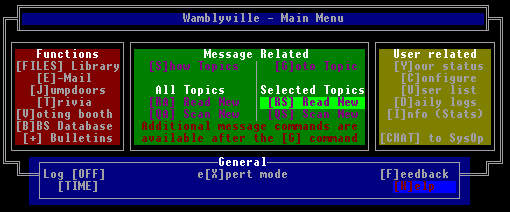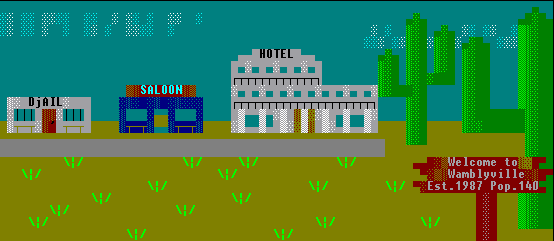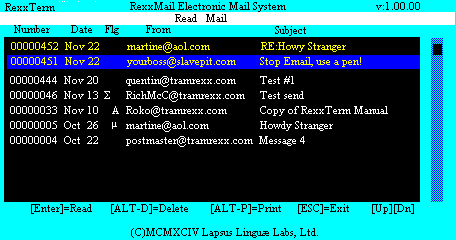Rexx has a long and colorful history, which to be properly told follows
the
efforts of three people. John Borowski, Raymond Wright, and Chris
Gorman
and their separate paths which collided to create Rexx...
![[Seperator Bar]](images/CBAR-BBB.GIF)
1987...In the Beginning
Sometime around 1986 three friends at Drew University (Tom Vogel, Neil
Clarke, and
Chris Gorman) created a BBS software package known as 2amBBS. In 1987,
One
member of 2am-Associates, Chris Gorman moved to
California
to attend Cal-Tec. In October of 1987 Wamblyville was brought
online in the Cal-Tec Dorm using the 2amBBS software.
| Flying high over what you thought was the
Western United States, you hear your helicopter making grotesque
noises. Soon, you begin to plunge. After a crash landing, you find
yourself somewhere east of: Wamblyville |
| The original login screen that identified the system |
John and Raymond were not idle during this time either, it was about
this time
that they were trying to create a BBS using a Tandy Color Computer. (We
won't go into
detail but suffice to say they learned not to try hot wiring a
hair-dryer to use as
a cooling fan...)
![[Seperator Bar]](images/CBAR-BBB.GIF)
1989
Jerel Crossland, a friend of Chris Gorman's bought and installed
2am-BBS
at his home in Glendale. The BBS was called Rivendale.
A user of Wamblyville named Glen Knowles (aka "STUPID") created and
tested
an online game called Crown and Country at Wamblyville.
At the urging of Raymond Wright, John became a member of the Rivendell
BBS.
After finding a listing for Wamblyville on Rivendale, John
Borowski joined Wamblyville as a user, under the name "ROKO"
which
was the name of a character in a short science fiction story he had
written
many years before.
In and about this time John Borowski was programming a
BBS
software package which he called Djinn-BBS. Along with the planning aid
of
his long time friend Raymond Wright. The first version
of Djinn
to be brought online was in Hollywood during this year and failed
horribly
due to administrative and personal financial problems. The Board was
shut
down when John moved to Norwalk to work for Bechtel. (The BBS was
online
for a total of 2 months.)
![[Seperator Bar]](images/CBAR-BBB.GIF)
Chris Gorman announced that he was
placing Wamblyville up for
sale due to his pending college transfer. After considerable debate
with
his then Wife Lucy [Dark Star on Wamblyville] and his Roommate (Raymond
Wright
no less) Wamblyville was purchased by John
 |
| The Wamblyville Main Menu c.1992 |
Borowski and moved to Los
Angeles. At that time, Wamblyville was running
on a Zenith 8088 with an 80mb Hard Drive. While the members wished
the new sysops good luck, Sadly,
many of the users who were regulars online stopped calling, as the
board
was now in the heart of Los Angeles instead of Pomona. To counteract
this
trend, a Newsletter was published which showed the new local calling
area
of the BBS, and a remote line was run from the Pasadena areas using the
old
bbs phone number. Many other changes were made, including a new look
(and
color) to the menus to spice up the failing board.
From October 1991 through January of 1992, Raymond Wright played the
role
of "Doctor Zul" and hosted a message
base on
Wamblyville with a Dear-Abby theme. During that time it had 52 message
posts
and was one of the most active message areas of it's time.
Also during this time, the users got a glimpse into the system
operators
home life during National Be kind
to Quentin Week
on Wamblyville...
![[Seperator Bar]](images/CBAR-BBB.GIF)
1992:
Wamblyville did have a family of users who were very close, as shown by
their message posts; including a multi-author
story
based on Star Wars. In the early part of 1992, Wamblyville was forced
offline due to personal
finances by John and Lucy Borowski. [Who made a forced move to San
Francisco]
 |
New ANSI GAP Login
Greeting screen created by
Lucy
Skywalker-Borowski [Dark Star] |
When the board was brought back online more changes were made to
attract
more users and make the board more active, John made the decision to
place
Wamblyville on one of the Message Echo Networks. In June of 1993
R.I.M.E.
was chosen as the network. But Because 2am-BBS did not then contain
support
for message networking, Wamblyville was changed to using the GAP-BBS
software
package.
During this time, Raymond brought online his own BBS which he called
"Wright
Access" using the MBBS software package.
In July of 1993, John and Lucy moved to Valley-Village (which is
between
Los Angeles and Glendale) and due to the volume of calls the board was
for
the first time made multi-user. (There were a total of 3 lines.)
By September, John realized that he was spending far too much money
operating the board free of charge. Up to this time, the board had been
on
a voluntary donation basis. Every user went away, and the board was
taken offline when John and Lucy
broke off their 10 year marriage.
By November, John had brought Wamblyville back online using the
original
2amBBS software and was now living in the same building where
Wamblyville
had been during it's first few months in Los Angeles. In order to
re-network
Wamblyville to RIME, he wrote UTI (Universal Text Interface) drivers
for
2amBBS. A QWK-Packet message system for 2am-BBS was also written by
John
at this time.
![[Seperator Bar]](images/CBAR-BBB.GIF)
1994:
In the early months of 1994, John and Raymond had strung a telephone
wire
down the side of the apartment building where they lived. (John was on
the
1st floor, and Ray was on the 3rd floor...Luckily they were on the same
side
of the building!)
 |
| The Wamblyville Door Menu c.1994 |
To this they attached a pair of 19200 baud short-haul modems and John
built
a gateway program which allowed Wamblyville and Write-Access users to
gate
between the two systems. One advantage to the users was that door
programs
were able to be shared by the users of both systems, allowing for much
more
interesting online gaming. (Much to the sadness of both John and Ray, Crown
and Country wouldn't run in network mode and the user of
Wamblyville
that had created the game had long since disappeared into the desert of
long-lost
BBS users...)
During these months, John continued working on a newer version of
Djinn,
which for the first time was written to be run in a PC based Unix
Emulator.
Much of the software was designed to emulate InterNet functions for
Unix.
(There is a Djinn-TSS Command List
and also the Djinn New User
Manual for the curious...which shows
the development trend in the direction of Unix.) On April 18th 1994
Djinn-4 was brought online. Within weeks, Dialup UUCP
InterNet connections were established for the newly born Wamblyville.
(As
wambly.com) The shared BBS doors (which needed DOS) were transferred to
a
second computer running the MBBS program called G-host and were placed
under
the administration of William Richardson. (William is Roxanne's current
husband...Roxanne was Raymond's Ex-Wife. We belong in Ripley's I
think...)
But once again, the money drain to operate all this was getting to be
too
much and once again Wamblyville was made a subscription system. And
once
again failed. After long periods without users, and much exasperation
on
John's part because people just couldn't get over what he called
"BBS-Brain"
(Users that couldn't make the transition from BBS Style commands to
Unix
Text commands.) he turned off Wamblyville's power; for the last time,
in
July of 1994.
John's boredom turned back to his first love, programming. Over the
next
few months he played with a new computer language he'd discovered,
called
Rexx. The initial programs didn't work well, but Djinn-5 was underway.
By the close of 1994, John had entered into a support agreement with
the
then head of sales for Telcom, Richard McCary. (John had been employed
by
Telcom for the last several years as a Telephone operator, and of late
as
the computer engineer.) "RexxMail" was brought online with one phone
line
and was stuffed under a desk in the Telcom sales office.
 |
| RexxMail Terminal Mail Index |
Access was obtained through a DOS terminal program called "RexxTerm"
which
used a suped-up x-modem to transfer queued files and contained a basic
mail reader.
The same UUCP-g drivers that had been built for Djinn were now used to
send
and receive InterNet Electronic mail under the registered domain name
of
tramrexx.com During this phase of development, the system accessed the
network
on a dialup UUCP line from Holonet networks.
![[Seperator Bar]](images/CBAR-BBB.GIF)
1995:
During 1995, John wrote several versions of RexxMail and RexxTerm and
included
support for FTP and Usenet news through the terminal program.
During this time, it was discovered that Richard McCary had no real
support
for the RexxMail and in fact had been hiding financial support for
RexxMail
in the Telcom Operating Budget! New agreements were made with the Owner
of
Telcom (Dennis Petros) for supporting RexxMail and it was moved to it's
new
location...in the Telcom Computer Room. (Where it still is.) Now being
in
close proximity to Telcom's mainframe computers, John began cross
linking
the features and functions of the two computers. E-Mail to FAX service
and
Alpha Pager technology was added to Rexx.
In the late part of this year, John decided that
the system needed it's own
identity and it was renamed to Rexx, and that John's company would be
called Rexx Electronic Communications. A new domain
name [rexx.com] was registered
with InterNic which finally completed the separation from Richard
McCary's
company, TRAM Telecommunications.
Work was begun on a custom computer system for
Rexx which merged micro and
mainframe technologies. The New Rexx hardware was based on a
mainframe's
passive backplane technology but used multiple 80486 microprocessors.
![[Seperator Bar]](images/CBAR-BBB.GIF)
1996:
Very early in 1996, John completed yet another version of Rexx, this
time
much different from the previous versions of Djinn and RexxMail. It was
intended
for the new hardware and operated in Microsoft Windows. It was designed
to
use Winsock to maintain a full-time connection to the InterNet. In
replacement
of the RexxTerm hookup, it contained a Unix Shell Emulator which
allowed
users to login and use readers and editors and some very basic finger
and
whois programs. (The editor for this early version of Rexx was
hi-jacked
direct from Djinn...it was the RJL-E Editor which was originally based
on
the editing capabilities of the BASIC from the original TRS-80's...) It
also
contained a very primitive web server, DNS server, and FINGER server.
Another change made was that Rexx had it's first full time connection,
which
was supplied by a camping dialup line to Earthlink Networks and used a
very standard PPP connect.
One day, John was playing with the whois reader he
was working on and just
for fun entered the name of a friend (Dwight Cass) that he'd known many
years
before. (And was very surprised to find that the friend was running the
InterNet
connection for Northrop-Grummond!) A bit of E-Mail was exchanged and
this
lead to dinner and eventually to a tour of Mr Cass's home system
[doghouse.la.ca.us] which was operating FreeBSD.
At Dwight Cass's suggestion, John began
investigating the FreeBSD Unix operating
system and late in 1996 Rexx was converted to FreeBSD. [Author's
note:
Yes, I know about Linux. That's what we were running Djinn-4 under, and
I
hated it then.]
The change to FreeBSD allowed Rexx for the first
time to fully use the shared
interrupt system which had been built into the Rexx hardware. In a very
short
time, John had built shared library routines into the FreeBSD Unix
kernel
which were taken from the original Djinn BBS system. The network
connection
continued to be through a dialup PPP connection, but compression
technology
was added.
![[Seperator Bar]](images/CBAR-BBB.GIF)
1997:
Now operating under FreeBSD, Rexx began offering PPP dialup service and
full
Unix shell service. The original Rexx web server was replaced with
Apache
and most other services were brought online, including FTP service. The
FTP
server included a large percentage of the original Wamblyville files
archive.
In February, the connection to the network was
changed to the more traditional
frame-relay and was peerd directly to CWIX, and a class "C" network
block was obtained. This change placed Rexx ONE hop from the commercial
InterNet
backbone.
Raymond used Rexx about this time to locate his
long-lost sister by tracing
records and library entries. (They had been separated as small children
when their parents divorced.)
![[Seperator Bar]](images/CBAR-BBB.GIF)
1999:
In the later part of 1999 John finally decided that things weren't
going the way
they were supposed to and told Mr Petros of Telcom that he wanted a
"divorce"
so that he could properly expand the system.
Now free of his obligations, John Immediately
started Rexx Expanding outward from Los Angeles,
reaching out across the United States. By December of 1999 Rexx had
several super-pop's with
390 local phone numbers.
![[Seperator Bar]](images/CBAR-BBB.GIF)
2000:
With the new Millennium came more expansion for Rexx. John replaced the
frame-relay lines that
Rexx had been operating with CWIX with HI-CAP Fibex lines and Lucent
Technologies
equipment.
New computers continue to populate the Rexx network, including a Unix
server
for the CSIT students of Los Angeles City College.
The dialup network continues to expand with independently connected
super-pops,
now supporting over 2000 simultaneous users on over 700 local phone
numbers.
It was also in 2000 that Netcom was sold to ICG/Mindspring (which ended
up being bought by Earthlink Networks.) As Mindspring and Earthlink
were not able to provide Unix service, a number of Netcom's users came
to Rexx (via an un-official referral.)
![[Seperator Bar]](images/CBAR-BBB.GIF)
2006:
During 2006, Rexx replaced it's older servers with new Nanotechnology
CPU Core systems. To support the new server technology, FreeBSD was
also upgraded to the latest edition. As the demand for dial-up access
was in an accelerating decline, Rexx closed it's nationwide dialup
service.
|
